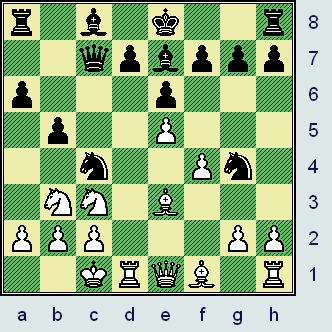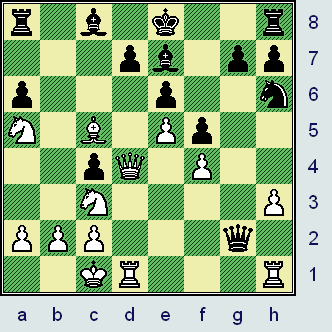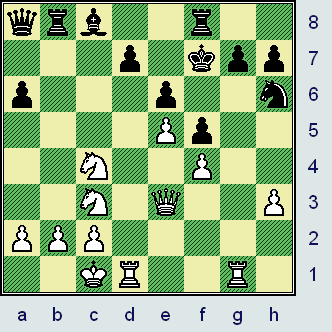Alexander Grischuk
(2719) - Jakov Geller
(2489)
|
|
|
[A.J. Goldsby I]
A game where it was not easy to
see exactly where Black went wrong.
(When I first went over this clash, - admittedly rather quickly - Black's
mistakes were not obvious.)
1.e4 c5;
2.Nf3 e6; 3.d4 cxd4; 4.Nxd4 Nc6; 5.Nc3 Qc7;
Thus far we have a Taimanov Sicilian.
[See MCO-14, beginning on page #300 for more details.]
6.Be3,
A standard developing move, White is probably aiming for the "English Attack" here.
More common would probably be 6.Be2, see MCO-14, page # 304.
[ In another famous contest, Bobby Fischer chose 6.g3,
"+/="
and went on to win a nice game.
(Vs. GM M. Tal)
[See MCO-14, page # 302; all columns and notes.] ]
6...a6;
7.Qd2,
This is a flexible move, White simply develops and adds control to the central dark squares.
(Meanwhile, he is hoping that Black will tip his hand sometime in the near future.)
[ Another line for White is:
7.Bd3
Nf6; 8.0-0 Ne5; 9.h3 Bc5; 10.Kh1
d6; 11.f4 Ng6; 12.Qe1 0-0; 13.f5,
"+/="
with White being slightly better ...
the first party has a dangerous initiative.
See the master battle: GM N. Mitkov (2532) - GM S. Rublevsky
(2670); [B48]
16th EUCup / Neum (R#1) /
24,09,2000. {White won a sharp game.}
[ See also MCO-14, page # 307; column # 14, and all the corresponding notes
for that particular column. ] ]
7...Nf6;
8.0-0-0 Bb4!?;
To me, this is a tad risky and winds up losing Black a few tempi.
(In the Sicilian, Black is usually best served by placing this piece on the e7-square.)
It surprised me to see that this is the top move choice in the new "Power-Book," although I am not sure that I entirely trust this as a safe option for Black.
[ To me, saner was: (>/=) 8...Be7;
9.f3 d6; 10.g4,
"+/=" 10...0-0;
when White holds the edge out of the opening, (nothing
new about that!) ...
but Black's position appears to be sound,
and fully playable.
One example would be:
GM Lenier Dominguez (2613) -
IM Erling Mortensen (2450); [B80]
ICT, 24th Politiken Cup /
Copenhagen, DEN; (R#10) 2002.
{White won an intense struggle,
although Black's defense could probably
be improved in several different places.}
]
9.f3 Ne5;
This is OK, 9...Na5; was also a move to be considered here.
10.Nb3! b5;
This looks dangerous, while the BK remains in the center.
(Castling or even >/= 10...d5 looked to be better.)
[ Perhaps even worse would be:
10...Nc4!?; ('?!') 11.Bxc4 Qxc4;
12.Bd4, "+/=" ('±')
and White is clearly better here.
]
11.Qe1,
(Maybe - '!')
The Queen moves to a safer square, now in some lines, the first player threatens Nd5 or even NxP/b5. (The alternative was to play 11.Bd4, instead.)
11...Be7?!; (Maybe - '?')
If Black was afraid to capture on c3, the Bishop should have never been developed to b4 ... in the first place! (IMOHO ... I would have taken on c3 before retreating.)
In order to avoid a disaster, Black had to play something like 11...Rb8.
[ Definitely worse was:
</= 11...0-0?!; 12.Nxb5! axb5;
13.Qxb4 d5; 14.Qc5!, "+/=" {D?}
and White is solidly better. ('±')
]
Now White lashes out.
12.f4! Nc4; 13.e5!, "+/=" 13...Ng4;
This isn't pretty, but the alternative now was to retreat to the g8-square.
|
|
r1b1k2r/2qpbppp/p3p3/1p2P3/2n2Pn1/1NN1B3/PPP3PP/2KRQB1R w
Several programs confirm that - while White is already solidly better - the first player's advantage is a long way from being decisive.
[ </= 13...Nxe3!?; 14.Qxe3 Ng8; 15.Qg3, '±' ]
14.Bd4! f5?;
It seems that simply castling was better than this provocative move, which winds up weakening Black's whole King-side.
[ After the following moves:
>/= 14...0-0;
15.Bd3, "+/=" 15...Bb7; White is solidly better.
(Yet this remains a fairly substantial improvement
over the actual course of the game.) ]
Now Black's Knight is kicked back to a
decidedly inferior square.
15.h3! Nh6; 16.Qf2!,
Now the White Queen (plus the WQB) put pressure down a key dark-squared diagonal.
16...Bb7;
"Normal" development, but the Knight on c4 may soon need some help ... so playing the d-Pawn to the d5-square might have been a better alternative.
17.Bxc4! bxc4;
This gives Black an ugly Pawn structure, but taking with the Queen wasn't much better.
(In fact, it may have been worse.)
[ 17...Qxc4!?; 18.Bc5 b4; 19.Na4 Bxc5; 20.Naxc5 Bd5; 21.Rd4 Qb5; 22.Rhd1, '±' ]
18.Bb6 Qc6?!;
Another bad idea, and it loses a tempo as well. (Black winds up snagging the g-pawn, but allows White too much play ... In the end, it is the open file on the K-side that spells out Black's speedy demise.)
[ Black's wisest course was to play (instead): >/= 18...Qc8; 19.Na5 Bb4;
20.Nxc4, '±' 20...0-0;
hoping to achieve a measure of counterplay on the b and c-files on the Q-side.
]
19.Na5 Qxg2!?;
Having said, "A" Black might as well follow up with "B."
[ After 19...Qc8; then 20.Rd4, '±' and Black loses a Pawn ...
and does not even have a shred of counterplay to show for it.
]
20.Qd4! Bc8;
{Box?}
There is not much choice now. (See the variation just below.)
[ Even worse was: </= 20...Qxh1?!;
and now after the moves 21.Qxd7+ Kf8;
22.Rxh1 Bxh1; 23.Qxe6,
"+/-" (24.NxP/c4 is next.) (and)
Black's Rooks
will never even get into the game.
]
21.Bc5!,
Once the dark-squared Bishops come off, the weakness of the d6-square becomes glaringly obvious to the whole world.
|
|
r1b1k2r/3pb1pp/p3p2n/N1B1Pp2/2pQ1P2/2N4P/PPP3q1/2KR3R b
Its safe to say that Black's opening experiment has been a disaster.
[ Also good was: 21.Rhg1 Qxh3; 22.Rxg7,
"+/-" with White
dominating play on BOTH sides of the chessboard!
]
21...Bxc5;
22.Qxc5 Kf7;
Everything probably loses now.
(Even so, >/= 22...Nf7 was probably a more sturdy defense.)
23.Qe3!,
The purpose of this move is not readily obvious. (White will play Rg1 next, but now does not want to drop the g-pawn ... plus Black's Queen is now in danger of being trapped.)
[ White could have also played: 23.Nxc4 , "+/-" which also yields
White a definite advantage here.
]
23...Rb8;
24.Rhg1 Qa8;
25.Nxc4 Rf8!?; (Really - '?')
Another error, but one that comes in a completely lost cause, so I find it difficult to be too hard on Black here. (The only move to continue the fight was
25...g6[].)
|
|
qrb2r2/3p1kpp/p3p2n/4Pp2/2N2P2/2N1Q2P/PPP5/2KR2R1 w
Now it is a simple win for White from this position.
It is now White to play.
26.Nd6+ Kg8;
Black's last move looks forced ...
(</= 26...Ke7?; 27.RxP/g7+, etc.)
This is the position for "The Problem of The Day" for Thursday; July 05th, 2007.
27.Rxg7+!,
"+/-" Black Resigns.
There is no point in continuing, White has a number of ways to win ... Black will even get mated if he is not careful.
A nice effort by Grischuk, his moves seem to flow effortlessly out of the position. (If you have it, I think that this game is also annotated in ChessBase Magazine, issue # 101. It is also annotated in the appropriate issue {9?} of ... "The Informant" series.
[ After the further moves: 27.Rxg7+! Kxg7; 28.Qg3+ Kh8; 29.Rg1 Ng4; This is forced.
(But not: 29...Rg8; ('?') 20.QxR/g8+!, and mate next move.)
30.hxg4 Qa7; 31.gxf5, "+/-" Fritz 10 shows that Black must give up his Queen or be mated. ]
Copyright (c) A.J. Goldsby, 2007. All rights reserved.


